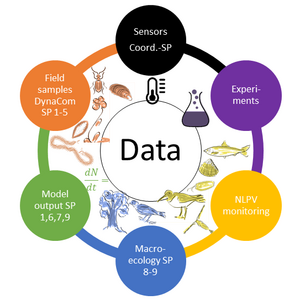Contact
Principal Investigators
Postdocs
National Park
Subproject 10
Synthesis of allometric and stoichiometric regulation of spatial dynamics
Subproject 10 consolidates the findings and integrates the outputs from all the subprojects to address four key inquiries: 1. Understanding the interconnections among pivotal traits—body size, C:N ratio, and mobility—across different trophic groups; 2. Developing methods to measure changes in traits due to environmental shifts like disturbances; 3. Assessing how stability operates across varying spatial scales, ranging from populations to metapopulations and from communities to metacommunities; 4. Exploring the correlation between species traits and their vulnerability to global changes.
Collectively, these questions delve into significant ecological aspects, considering the distinct studied system in the Dynacom unit. Our investigation of these timely matters involves employing intricate and complementary frameworks, including the Trait Driver Theory, diffusion maps, stability scaling, and multidimensional trait frameworks. Ultimately, this subproject aims to establish theoretical foundations that can inform tailored conservation strategies.
In Phase 2 of DynaCom, the research unit aims to generalize its spatial trait-based food-web perspective to the dynamic interplay between stochastic and deterministic assembly of communities and the functioning of ecosystems. The role of SP 10 is to integrate the trait information across the different dimensions and organism groups and to provide a synthetic view on the multiple dimensions of stability in response to environmental changes in a spatial context. Building upon the advances from phase 1, we organized this project around four workpackages. In WP 10.1, we will integrate the information on resource demand and body size across the research unit to identify allometric and stoichiometric constraints of trait composition. Thereby, we address the fundamental question whether traits, which by definition need to be measured in different ways for different organism groups, can be reflected in common currencies such as nutrient demand and body size. In WP 10.2, we will use the integrated trait information across all organism groups in DynaCom to establish the overall trait space in the species pool of the Wadden Sea and to test how much of this trait space is covered (filled) in local assemblage and regional metacommunities. Using a set of recently devised methods (hypervolumes, diffusion maps), we provide a true synthesis of the work in DynaCom. In WP 10.3 we turn the focus to stability is key property in response to environmental change. Here, we will provide a synoptic analysis of stability by using DynaCom data and additional monitoring time series to assess how spatial scaling affects temporal stability in metacommunities and experimental data to address post-disturbance recovery. The final WP10.4 aims at making the DynaCom outcome transferable into a management context. We will integrate information on population changes, rarity, and environmental drivers into a vulnerability index, and explore whether we can associate vulnerability to traits.




